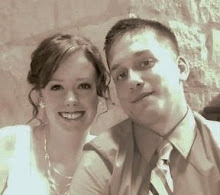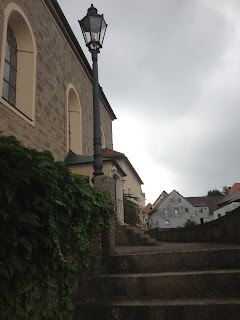The castle there was a stronghold of the House of Hohenstaufen, "a dynasty of German monarchs in the High Middle Ages, reigning from 1138 to 1254." (Or so says Wikipedia) It was destroyed, reportedly, in the Thirty Years' War and was never rebuilt. It's one of the most notable castle ruins in the Upper Palatinate. Considering the windy European and tree-lined roads I had a hard time getting a good picture of it from below but from what I've seen of other people's pictures it's pretty impressive up close. It lords over the entire town and is visible from almost anywhere down below.
Yesterday I was reading up on the town and learning more about the concentration camp that used to be there. I first learned about it from my sister (here's your shoutout Megan!) who has been reading a book about Dietrich Bonhoeffer, the German pastor who was a part of one of the plots to kill Hitler. He was executed at the camp there. Upon realizing that this place was so close to us I decided to go, especially with the castle to see there too. And I figured the timing was right. Without Liam to chase around I could actually take my time looking around the area. Will and I have planned on going to a camp too but wanted to explore Germany on our own first, to get a sense of where it is we're living now. And I feel like one works oneself up to visiting a place like that. Americans really know very little about Germany considering how places like France and Italy nearby are such popular American tourist destinations. Our views of Germany seem to be of beer... and WWII. Both accurate but a little restrictive as there is so much more to this country that we've overlooked.
Initially arriving I decided to go to the camp first. I didn't think I was going to be at the camp long so I figured I'd see the castle afterwards. To make a long story short I changed my mind a couple times. Upon arriving at the camp I didn't feel I was quite ready to bring myself to go so I backtracked and went in search of the castle instead. I ended up parking further away from it than I had realized, but finding how beautiful the town was I just decided to walk around a bit.
I love these houses, especially how there are flowers spilling out of almost every window. Germans definitely love their gardening. This was one of the churches in town. I loved the ivy climbing down the wall onto the stairs.
These towns built into hills remind me of a lot of what we saw on our trip down to the Alps in June. It was very pretty, even on a dreary day like today. And it's in a fairly remote location in the sense that there are no big cities nearby. Here and there people stood outside talking to their neighbors, sweeping off their porches. I felt like the only tourist in the whole town, or American to say the least.
I took this picture without realizing the houses up on the hill are the original houses that many of the higher-ranking SS officers lived in and are they are still occupied today. (The area where the camp is is just off to the left of this picture.)
I have yet to figure out what these doors built into the mountain are for. I noticed some of these at Parkstein yesterday so I'm not sure if it has some correlation with a castle being there or not.
Before I go on however I wanted to forewarn those reading that the following pictures are of the concentration camp. I realize it's not something everyone wants to look at, so I felt a fair warning was needed. I was conflicted about taking pictures at first but once there I felt moved to, so I did. Not of everything, of course. But I feel that I tried to accomplish this in a respectful way. (At least as much as one can with an IPhone. I didn't feel carrying my larger camera was appropriate.) So, with that being said...
The camp was started in May 1938 and was originally intended for criminals, "asocial" people and Jews. Over time political prisoners and POWs were added. The first building you encounter is the SS Headquarters. It stands about 100 meters in front of what used to be the camp gate, the place that separated the SS part of the camp from the prisoners'.
Where the metal poles are is where the gate used to be. The two stone posts (one bearing a sign that read "Arbeit macht frei," ("Work makes you free") were removed to the memorial at the back of the camp.) These are the two of the main buildings left standing. The one on the right was the "laundry facility" with the prisoners' "washroom" in the basement. The building on the left was the camp kitchen. Both buildings now house exhibits. The open space between the buildings was the roll call grounds where roll call was taken twice a day. When the camp first opened in 1938 there were 400 prisoners. By the time the camp was liberated on April 23, 1945 they numbered over 15,500. (Only about 1,500 remained behind at the camp and were present for the actual liberation. The remaining 14,000 had left on a "death march" towards Dachau three days prior.)
Inside the chapel, plaques along the wall commemorate the number of prisoners from each country represented at the camp. The two Americans were unknown airmen.
Bust of Dietrich Bonhoeffer in the chapel. He was executed 14 days before the camp was liberated.
View from inside the chapel.
Another of the remaining guard towers.
And the above tower up close...
Behind and below the backside of the main part of the camp is the crematorium shown at the bottom of the hill in this picture. The fence posts on the right side of the stairs are the original barbed wire fence posts. The two stone posts midway down the hill just above the crematorium are the original gate posts previously mentioned. They were relocated to serve as part of the memorial that lies just to the left of this picture.
The "Valley of Death," the oldest Holocaust memorial in Bavaria. Shown is the Square of Nations, Pyramid of Ashes, where an estimated 5,000 people remain, a mass execution site and the crematorium in the background.
Plaques placed by survivors of the camp honoring the U.S. Army units directly involved in the liberation.
And part of the Square of Nations
I usually have quite a bit to say on the subject of how I feel but this isn't one of those times. And besides, I think the pictures speak for themselves. Maybe that's why I was so drawn to take pictures of some of what was there. They will show things I don't have the language to express.
In short, I'm into history. And not everyone is. That's okay. I've truly started to acknowledge that I am blessed to be living in a place with a very deep and rich history. One with it's own, often very different, perspective on all those lessons I learned in school. But I would definitely recommend visiting a camp to any American who has the means and the opportunity. It's easy to shy away from it because it's an uncomfortable experience. But it is an experience you will never be able to compare to anything else in your life. It is both humbling and overwhelming. And in this way, through our simple acknowledgement, we give a voice to the voiceless.






 /
/














